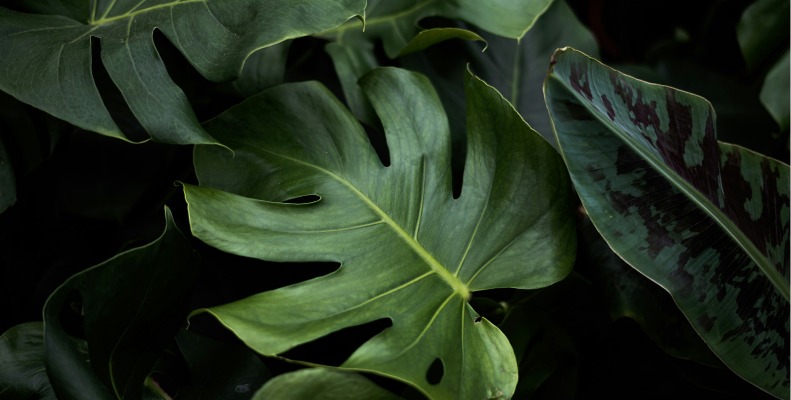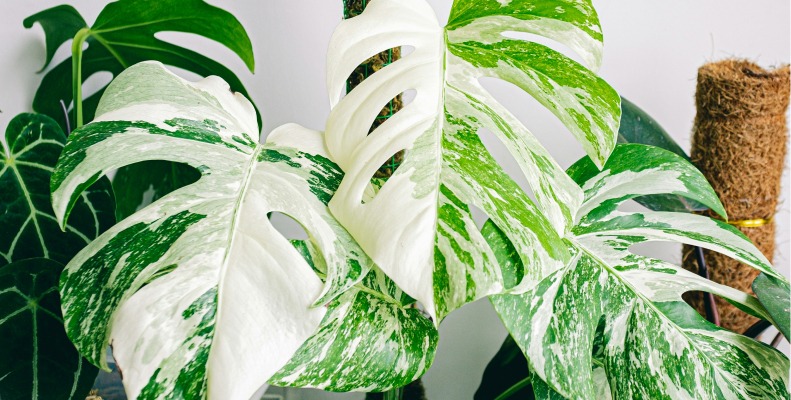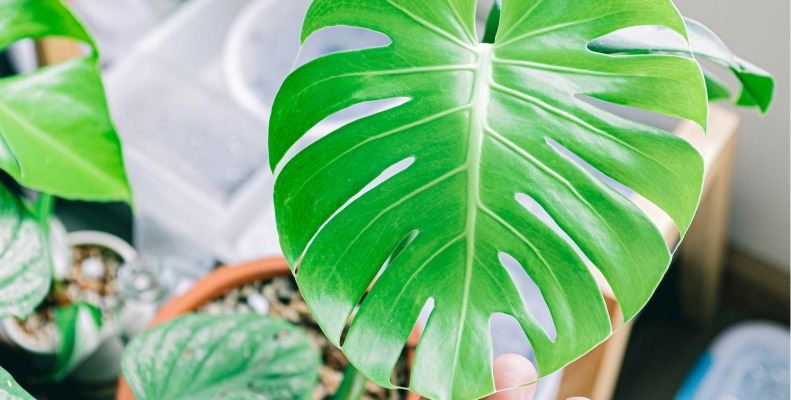Monstera plants are originally from Central America and are known for their natural leaf-holes. This feature gives them the nickname, Swiss Cheese Plant. Proper Monstera plant care is essential to ensure these vibrant plants thrive indoors, bringing a touch of the tropics into your home.
Among the many varieties of Monstera, Monstera deliciosa and Monstera adansonii are grown as houseplants. Monstera adansonii has longer leaves and enclosed holes. Monstera deliciosa’s holes open up as the leaf grows. Though people have known these plants for a long time, they were formally described in the early 20th century.
Key Takeaways
- Monstera plants are tropical vines and shrubs native to Central America.
- They are known for their unique leaf-holes or fenestrations.
- Monstera deliciosa and Monstera adansonii are the two main species cultivated as houseplants.
- Monsteras were formally introduced to the botanical world in the early 20th century.
- Proper care is essential for Monstera plants to thrive indoors.
Introduction
Monstera plants, also known as Swiss cheese plants, are beloved indoor gardening favorites. They add a tropical vibe to any home. The Monstera plant stands out with its unique, beautiful leaves.
Just like any other plants, Monstera needs the right care to grow well. This article will cover the basics of caring for a Monstera plant. Topics like watering, fertilizing, and where to keep the plant will be explained clearly.
By the end, you’ll know how to care for a Monstera deliciosa. You’ll be ready to make your living space lively with a healthy Monstera.
About the Monstera Plant
Monstera plants are from the forests of Central America. They are loved for their unique leaf-holes, earning them the nickname Swiss Cheese Plant. These holes, called fenestrations, are thought to help the plant catch more sunlight on the ground of the forest.
Species and Origin
Two kinds of Monstera are popular as indoor plants – Monstera deliciosa and Monstera adansonii. You can tell them apart because Monstera adansonii’s leaves are longer and have enclosed holes.
Fenestrations and Leaf Holes
The leaf holes of Monstera deliciosa spread to the edge as they grow. This is one reason why Monstera plants are a favorite among plant lovers. The unusual leaves bring a tropical feel to any space.
Interactive Light Calculator
Lighting Requirements
Monstera plants come from the tropical rainforests of Central America. They live on the ground under larger trees. This has made them used to not getting a lot of light, especially direct sunlight. Too much direct sun can hurt their leaves, causing them to get damaged easily.

Bright, Indirect Light
Your Monstera will do best with bright, indirect light. This could mean placing it by a north-facing window. Or picking a room that’s well-lit but doesn’t have the sun directly coming in. Doing this helps your plant get enough light for growth without the risk of sunburned leaves.
Acclimating to Direct Sun
When you need to move your Monstera to a different light level, do it slowly. They get shocked easily if the light change is too sudden. Gradually introducing them to new light types lessens their stress and keeps them healthy.
Using Grow Lights
Using grow lights can be a great choice if your room doesn’t get enough natural light. LED grow lights are ideal for this. They mimic the light Monstera plants need for food and growth, but don’t give off too much heat. Remember, your Monstera should get 6 to 8 hours of light daily.
Watering Needs
Watering is key to keeping your Monstera healthy. Doing it right can help your plant live long. Monstera plants like to be kept a little wet but not soaked. The watering schedule changes based on the plant’s size, pot, soil, and the room’s temperature and humidity. Usually, you should water them when the top inch of soil is dry. This can mean watering them once a week to once every two or three weeks.
Signs of Over and Under-Watering
It’s easy to water Monstera plants too much or too little. But, both are bad for the plant. Too much water can rot the roots, turning leaves yellow and making them wilt. Then, the plant might even die. On the other hand, not enough water can dry out the plant, causing leaves to turn brown and become crispy. It can also make the plant stop growing. So, it’s important to find the right balance and not water too often to fix under-watering.
Monstera plant care
Monstera plants love the humid climate of tropical rainforests. They do best with humidity between 60% and 80%. If the air is dry, their leaves might turn brown and the plant will grow slowly. But, if it’s too humid, the plant could get sick and its leaves might turn yellow and droop.
Humidity and Temperature
To keep your Monstera plant happy, make sure there’s enough humidity. Ways to do this include using a humidifier, grouping the plants, misting the leaves, or a pebble tray. Monstera plants like it warm, between 65°F and 85°F (18°C to 29°C). They don’t like cold at all and can get hurt or die below 50°F (10°C).
Increasing Humidity
Here are tips to bump up the humidity for your Monstera plant:
- Use a humidifier to add moisture to the air around your plant.
- Group your Monstera plant with other plants to create a shared, moist atmosphere.
- Regularly mist the leaves to mimic a humid environment.
- Set your Monstera plant on a pebble tray in water to boost air moisture.
Keeping your Monstera plant in the right kind of environment is key. This way, it will flourish and keep making its unique, windowed leaves.
Soil Requirements
Monstera plants like soil that drains well and is full of nutrients. You can mix peat moss, perlite, and vermiculite for them. This mix helps hold in moisture while avoiding waterlogging.
Leca balls are another good option for Monstera. They keep the soil from becoming too wet. This prevents the roots from rotting.
Well-Draining Soil Mix
A well-draining soil mix is key for Monstera’s health. It keeps the roots from getting too wet or dry. This stops problems like root rot and fungal disease.
Use materials like peat moss, perlite, and vermiculite in the soil. They provide great drainage and keep nutrients available to the plant.
pH Level
Monstera plants grow best with a pH between 5.5 and 7.0. If the soil is too acidic or alkaline, the plant can’t absorb nutrients well. This can lead to poor growth and yellow leaves.
Use a pH meter to check the soil. Adjust it as needed to keep your Monstera healthy.
Fertilizing and Pruning
Monstera plants need special nutrients to grow well. Fertilizer is key in caring for them. They must get nitrogen, phosphorus, and potassium to thrive. Lacking these can cause the plant to not grow well, change color, or die.
Balanced Fertilizer
For your Monstera, a balanced fertilizer is best. It should have about the same of N, P, and K. Feed it in spring and summer, not so much in winter.
Pruning Techniques
Monstera plants benefit a lot from regular trimming. It helps the plant get bushier, keep shape, and not get too tall. Use a sharp, clean tool and cut above a leaf to spur new growth.

Common Pests and Diseases
Monstera plants, though resilient, can fall victim to a range of pests and diseases that can impede their growth and overall health. Understanding these common issues and knowing how to address them is crucial for maintaining a thriving Monstera.
Spider Mites: One of the most prevalent pests affecting Monstera plants is spider mites. These tiny arachnids are barely visible to the naked eye but can cause considerable damage by sucking sap from the leaves. A telltale sign of a spider mite infestation is the appearance of speckled, yellowing, or browning leaves. To prevent spider mites, regularly inspect your Monstera, especially the undersides of the leaves where these pests tend to congregate. Increasing humidity around the plant can also deter spider mites, as they thrive in dry conditions. If an infestation occurs, a strong spray of water can help dislodge the mites, or you can apply insecticidal soap or neem oil for more severe cases.
Mealybugs: Mealybugs are another common pest that appears as small, cotton-like clusters on leaves and stems. These pests feed on plant sap, which can stunt growth and cause leaf drop. To manage mealybugs, isolate any infected plants to prevent the spread to other plants. Wiping the affected areas with a cotton swab dipped in rubbing alcohol can help eliminate mealybugs. For larger infestations, insecticidal soap or neem oil can be effective treatments.
Scale Insects: Scale insects manifest as small, brown bumps on the stems and leaves of the Monstera. These pests also feed on sap and can weaken the plant over time. To treat scale infestations, manually remove the scales with a soft brush or cloth. Applying horticultural oil or insecticidal soap can help control and prevent further infestations.
Root Rot: Among the diseases that can affect Monstera plants, root rot is particularly detrimental. It is often caused by over-watering and poor soil drainage, leading to a mushy, foul-smelling root system. Symptoms include yellowing leaves and wilting. To prevent root rot, ensure your Monstera is planted in well-draining soil and that the pot has proper drainage holes. Water the plant only when the top inch of soil is dry. If root rot is detected, remove the affected roots and repot the plant in fresh, dry soil.
Leaf Spot: Leaf spot diseases, caused by fungal or bacterial infections, result in brown or black spots on the leaves. Improving air circulation around the plant and avoiding overhead watering can help prevent these infections. If leaf spot disease occurs, remove and dispose of the infected leaves and consider using a fungicide to treat the plant.
Seasonal Care Tips
Adjusting care routines according to the seasons can significantly impact the health and growth of your Monstera plant. Here are some tips to help your Monstera thrive throughout the year.
Winter: During winter, the reduced natural light can be challenging for Monstera plants. Move your Monstera closer to windows to maximize the available light, or use grow lights to supplement the natural light. Watering should be reduced as the plant’s growth slows down; only water when the top inch of soil feels dry. Indoor heating can dry out the air, so maintaining humidity is crucial. Use a humidifier, pebble tray, or regularly mist the leaves to ensure adequate humidity levels.
Summer: In summer, Monstera plants often experience faster growth due to increased light and warmth. However, too much direct sunlight can scorch the leaves. Position your Monstera in a spot with bright, indirect light to avoid this. Increase the frequency of watering to accommodate faster growth and higher evaporation rates, but ensure the soil remains moist and not waterlogged. Maintain high humidity by misting the leaves or using a humidifier, especially during hot, dry periods.
Propagation Methods
Propagating Monstera plants is a rewarding way to expand your collection and share with friends. The most common method is through stem cuttings. Here’s a step-by-step guide to successfully propagate your Monstera.
- Choose a Healthy Stem: Select a healthy stem with at least one node and an aerial root. Nodes are crucial as they are the points where roots will develop.
- Cut the Stem: Using a clean, sharp knife or scissors, cut the stem just below the node. Ensure the cutting tool is sterilized to prevent disease transmission.
- Prepare for Propagation:
- Water Propagation: Place the cutting in a jar of water, ensuring that the node is submerged. Change the water every few days to prevent stagnation. Roots should begin to develop within a few weeks.
- Soil Propagation: Alternatively, you can plant the cutting directly into moist, well-draining soil. Keep the soil consistently moist until the roots establish.
- Care for the Cutting: Place the cutting in a location with bright, indirect light. Once the roots are established, treat the new plant as you would a mature Monstera.
Environmental Impact and Sustainability
Caring for indoor plants like Monstera can be environmentally sustainable with mindful practices. Here are a few tips to ensure your plant care routine is eco-friendly:
- Reduce Plastic Use: Opt for biodegradable pots or containers made from recycled materials instead of plastic pots. This reduces plastic waste and its environmental impact.
- Conserve Water: Collect rainwater to water your plants, reducing reliance on tap water. Implement efficient watering practices to avoid waste, such as watering early in the morning or late in the evening to minimize evaporation.
- Sustainable Soil Practices: Use organic soil mixes and compost to enrich the soil naturally. Avoid peat-based products, as peat harvesting is not sustainable and damages natural ecosystems.
- Eco-friendly Pest Control: Use natural pest control methods, such as neem oil, insecticidal soap, or introducing beneficial insects, instead of chemical pesticides that can harm the environment.
- Energy-efficient Lighting: If using grow lights, choose energy-efficient LED lights. They consume less power and have a longer lifespan, reducing energy consumption and waste.
By incorporating these sustainable practices, you can reduce your environmental footprint while enjoying the beauty and benefits of your Monstera plants.
Conclusion
By following the tips and advice in this guide, you’ll soon be a Monstera plant care expert. Each Monstera is different, so pay attention to what yours needs. Then, tweak your care routine as needed.
Lighting, watering, soil, and other factors are key to a happy Monstera. Get these right, and your plant will thrive, decorating your space for years.
This guide is perfect for any indoor gardening fan or someone new to foliage plants. It covers everything you need to know, making sure your Monstera grows well.
With the info and tips here, you’re set to become a Monstera master. Soon, you’ll see why so many people love these plants.

